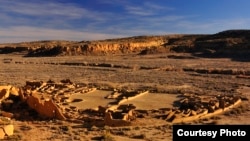A massive baby boom that began 1,500 years ago in the American Southwest and ended around 1,300 A.D. could offer valuable insight into modern-day overpopulation, new research suggests.
Examining thousands of remains of Native Americans and their tools gathered from the Four Corners region (where Arizona, New Mexico, Colorado and Utah meet), scientists painted a picture of how several societies evolved from hunter-gatherers into farmers.
That transition, researchers say, led to birth rates that "exceeded the highest in the world today."
"It's the first step toward all the trappings of civilization that we currently see," said Tim Kohler, an anthropologist at Washington State University and co-author of a paper on the boom, in a statement.
Some of the groups in the region were very culturally advanced, with irrigation, ball courts and housing for elite families, researchers said.
But the success was a “trap.”
In the northern part of the Four Corners, the population climbed as high as 40,000 by the mid-1,200s. But in a short span of 30 years, “it was empty, leaving a mystery.”
The reason for the baby boom was maize, or corn.
Researcher shows that it was grown in the region as early as 2,000 B.C., but that it initially had a limited impact on population growth.
By 400 B.C., however, maize provided 80 percent of the region’s calories, researchers said.
This led to a rise in the birth rate that lasted until about 500 A.D., but the rate varied around the region.
Four hundred years later, populations were still high, but the birth rate began to “fluctuate.”
A massive drought struck in the mid 1,000s to 1,280 causing farmers to leave and conflict to ensue. Still, the birth rates remained high in the northern part of the region.
"They didn't slow down," said Kohler. "Birth rates were expanding right up to the depopulation. Why not limit growth? Maybe groups needed to be big to protect their villages and fields.”
Why the population collapsed is unclear. Researchers suggest that that there were perhaps too many to feed as the climate deteriorated. This, they say could have led to people leaving, making it “harder to maintain the social unity needed for defense and new infrastructure.”
"We can learn lessons from these people," said Kohler.
The report was published in this week's issue of the journal Proceedings of the National Academy of Sciences.
Ancient Baby Boom Could Foreshadow Future
- By VOA News








